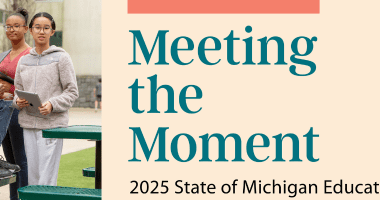Opinion: Michigan is failing our English learner students, and that has to change
Michigan’s population outlook is dire. Our state had the 49th slowest rate of growth in the entire U.S.
If Michigan leaders still have hope of growing our state’s population and economy, they should start by ensuring the students who are the most underserved in our state have the resources they need to thrive: English learners.
Here’s why: Michigan’s immigrant population is one of the few areas of growth for our state. In fact, 13% of children are considered to be part of immigrant families.
Immigrant community a bright spot in Michigan
Immigrants, many of whom are learning English, are also an important part of our economy and business community.
More than 1 of every 10 business owners in Michigan are immigrants, even though immigrants make up just 7% of Michigan’s population. Additionally, they bring a significant revenue base to our economy, generating over half a billion dollars in business revenue, according to the American Immigration Council. Moreover, most of Michigan’s newcomers have attended college, with almost half earning a college degree or higher.
Michigan is failing English learner students
Michigan’s English learner population is rising in our schools, too, according to the Citizens Research Council of Michigan, while the overall K-12 student population has dropped. Yet it’s become a sad reality that Michigan is failing English learner students, and that has to change.
On the 2023 M-STEP, only about one-fourth of English learner students were proficient in third grade reading. And worse still, that’s dropped significantly since 2019, when only a third were proficient.
Additionally, only 75% of English Learners graduate within 4 years. This is below the statewide average of 82%.
Educators and school leaders are doing everything they can. But for many years, our state has drastically underfunded the needs of English learners, allocating just 1.7% to 15.4% additional funding for each English learner, based on English language proficiency.
Compared to states like Maryland, which is phasing in a weight of 85% more, and Georgia which now allocates an astounding 160% more funding to English learners, Michigan long neglected these students.
In fact, among 31 states with similar funding formulas, Michigan ranked 26th for our English learner funding, according to an analysis by The Education Trust-Midwest.
Additionally, we know that English learners face challenges to their learning, including economic hardship, under-resourced schools, lack of ESL/bilingual certified teachers and less rigor in their schools and classrooms. That’s on top of trying to learn English and master their coursework at the same time.
Increasing funding for English learners is critically important to provide them with the additional resources and instructional supports necessary for language acquisition, including varied support services and rigorous curricula.
Committed leaders make change
And while there’s no question that the conditions for English learners have been unacceptable for far too long in Michigan, we have hope.
Michigan stakeholders took a bold step when they identified strategies to grow our population. Among them: Creating a well-aligned, accountable and adequately funded lifelong learning system.
That should include significant increases in funding for English learners.
Last year, lawmakers made the largest investment for English learners in recent memory and set new funding weights of 35%, 50% and 75% more. Yet to fully fund these weights for English learners, Michigan would need to invest at least an additional $240 million annually, according to an analysis by The Education Trust – Midwest.
Even with these historic changes, we are still far behind what leading states practice and research recommends should be invested.
What we can do now
We celebrate the efforts of lawmakers to invest more in students with the greatest needs, and now urge them to commit to these four things in this budget cycle:
- Double the funding for English learners in the FY 25 school aid budget to $80 million. That will get us on a path to fully fund the weights in the law within 5 years.
- Increase the weighted funding formula to at least 80%-100% to be more aligned with what leading states practice.
- Expand the funding formula so more students who have not yet mastered English receive additional funding and supports. As it stands now, only students who score at the lowest three levels on the test taken annually by English learners – the WIDA — receive the weighted funding. We support expanding that so students scoring in levels 3-6 receive additional funding, as well.
- Conduct a deeper landscape analysis of the profile of Michigan English learners including languages spoken, concentration across the state, and available services for English learner students.
In a state where we are losing talent and population, we have to face the reality that English learners and immigrants are key to Michigan’s future health.
Supporting our English learners is both a practical and a moral issue that we can no longer ignore.
This opinion piece appeared in Bridge Michigan. Angela G. Reyes, executive director of Detroit Hispanic Development Corp.; Steve Tobocman, executive director of Global Detroit; Amber Arellano, executive director, The Education Trust – Midwest; Cindy Gamboa, executive director, MI Poder; Rogelio Landin, president, LULAC Council #11054; Stephanie Lopez Gilmore, president, MANA de Metro Detroit, and Jose Luis Orozco, Jr., executive director, Voces of Battle Creek, co-authored this commentary.





